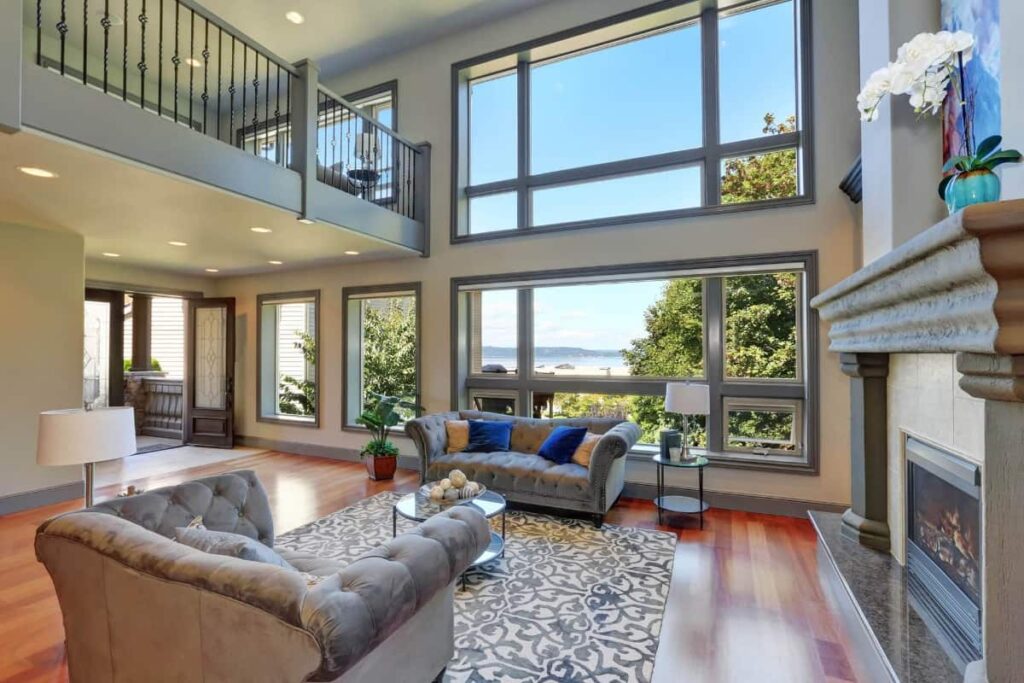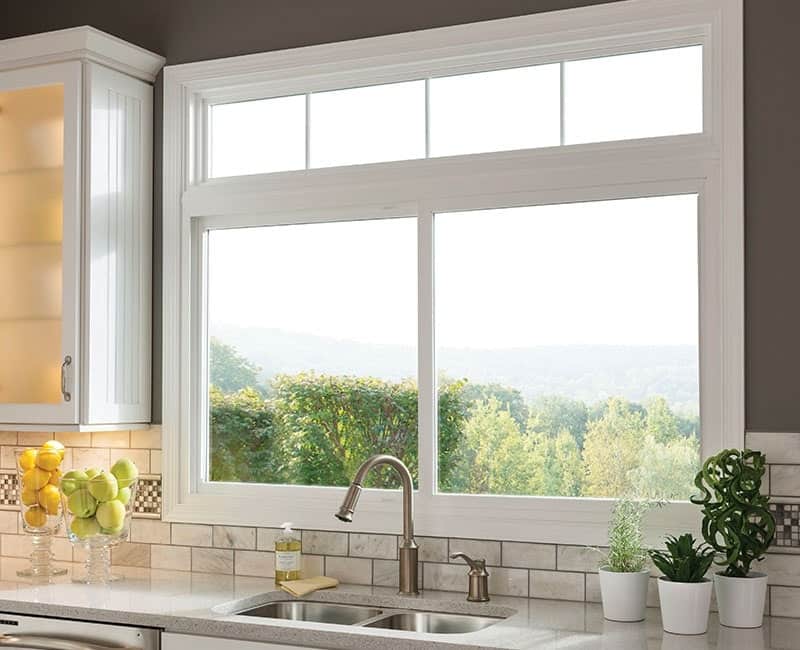How Much Does a Picture Window Cost?
Picture windows usually cost between $700 and $1,300, though prices can start as low as $400. However, custom or larger designs can go beyond $2,000. The final price depends on factors like size, material, style, glass type, and labor.
What Factors Affect the Cost of a Picture Window?

When choosing a picture window for your home, it’s essential to know the factors that affect its cost. Here’s what you should consider:
Picture Window Sizes
The window sizes and prices go hand in hand, primarily because larger windows require more materials and labor.
Since picture windows are usually priced per square foot, a larger picture window will generally cost more.
However, it’s worth noting that you might actually pay less for a larger standard-size window compared to a smaller custom-sized one.
- Picture Window Size Average Cost
- 24" x 36" (6 SF) $120 – $300
- 36" x 48" (12 SF) $240 – $600
- 36" x 60" (15 SF) $300 – $750
- 48" x 48" (16 SF) $320 – $800
- 36" x 72" (18 SF) $360 – $900
- 48" x 60" (20 SF) $400 – $1,000
- 60" x 60" (25 SF) $500 – $1,250
Glass Type
The type of glass you choose influences the cost of a picture window.
You’ll probably have the option to choose between single, double, or triple-pane glass, depending on your needs.
Single-pane glass is the simplest and most affordable option available. However, it provides minimal insulation, making it less energy-efficient.
Double-pane glass, which is more common, consists of two layers of glass with an insulating layer of gas in between, offering better energy efficiency but at a higher cost.
Triple-pane glass, with three layers, offers even greater insulation but comes at a premium price.
- Window Type Estimated Cost Per Window
- Single-pane windows $400 - $1,100
- Double-pane windows $700 - $1,300
- Triple-pane windows $1,000 - $1,600
Material
- Picture Window Material Average Cost
- Vinyl $450 - $1,150
- Aluminum $450 - $1,200
- Fiberglass $600 - $1,600
- Wood $800 - $1,800
Vinyl
Vinyl frames are among the most affordable options, typically ranging from $450 to $1,150 installed.
They are durable, low-maintenance, and available in custom sizes. However, they may not be as energy-efficient as other materials and offer fewer finish options.
Aluminum
Aluminum frames usually cost between $450 and $1,200. They are durable, lightweight, and require no painting or staining, but they are prone to condensation and can corrode in coastal environments.
Additionally, aluminum frames generally have a higher U-value, meaning they are less effective at insulating.
Fiberglass
Fiberglass is a higher-end option, costing between $600 and $1,600. It is excellent for extreme climates, offers superior energy efficiency, and provides better sound insulation.
However, fiberglass frames can be more expensive and are prone to fading in the sun.
Wood
Wooden frames are the most expensive, typically ranging from $800 to $1,800. They offer a timeless, aesthetic appeal and can be eco-friendly if made from sustainably harvested wood.
However, wood requires regular maintenance and is susceptible to warping, rotting, and insect damage, especially in humid climates.
Hybrid (Dual-Fuel) Heat Pumps
Hybrid heat pumps combine an electric heat pump with a gas or oil furnace for additional efficiency in cold climates, with costs ranging from $2,000 to $8,200.
Style and Shape
Picture windows come in a variety of shapes and styles to match your home’s architecture.
Standard rectangular or square options are usually the most budget-friendly, while custom shapes like circular, oval, or octagonal tend to be pricier due to the extra work involved in manufacturing and installation.
Keep in mind that opting for a non-standard shape will typically raise the price, both for the window unit and the labor needed to install it.
- Picture Window Shape Estimated Cost
- Square $700
- Rectangle $800
- Radius/arched $1,000
- Round $1,300
- Custom Shape $2,000+
Labor
Labor plays a big role in the cost of installing a picture window, often making up a significant part of the overall expense.
Professional window installers typically charge between $40 and $65 per hour, or roughly $100 to $500 per window, depending on the job.
The exact labor cost can vary based on factors like the installation’s complexity, the size of the window, and where it’s being installed.
For example, larger or higher windows that need scaffolding or involve structural changes will increase labor costs.
Additional factors like specialized equipment, weatherproofing, or necessary repairs around the window can also add to the expense.
Other Factors that Affect the Cost of a Picture Window

Energy Star Rating
Replacing existing windows with ENERGY STAR-certified ones can reduce energy costs by up to 13%. However, these energy-efficient windows usually come with a higher price tag due to features like low-E coatings, gas fills, and better frame materials.
These features improve insulation, helping to keep your home warmer in winter and cooler in summer, which results in lower energy bills over time.
Although the upfront cost is higher, the long-term savings on heating and cooling, along with possible tax credits, make it a worthwhile investment.
Brand
The brand of a picture window plays a big role in its cost, influenced by factors like material quality, energy efficiency, and the features different manufacturers offer.
Premium brands like Pella and Marvin typically come with higher price tags because they offer top-notch energy efficiency, durability, and advanced customization options.
In contrast, more budget-friendly brands like Simonton and Milgard provide affordable alternatives that perform well but may lack some of the premium features.
Beyond the base price, brand reputation and warranty offerings also affect pricing. Brands with longer or more comprehensive warranties usually charge more, which shows their confidence in the product’s durability and performance.
- Brand Average Unit Price
- Andersen $200 – $1,000
- Pella $400 – $1,500
- Marvin $500 – $1,500
- Champion $400 – $800
- Harvey $475 – $1,000
- Kolbe $250 – $800
- Milgard $300 – $850
- Simonton $400 – $600
New vs. Replacing Picture Window
Remember, the cost to replace a picture window differs from the cost of installing one from scratch.
When you’re installing a new picture window for the first time, the process is more involved. A contractor will need to consult with an engineer to ensure the wall can support the new opening, and then a framer has to create the space for the window.
All this could add up to the total cost as compared to what you can expect the replacement picture window prices to be.
The expenses for hiring an engineer can vary, typically falling between $1,700 and $3,100. Additionally, framing contractors often charge hourly rates ranging from $66 to $121 for their work.
Picture Window Pros and Cons
Advantages and Disadvantages of Picture Windows
- Energy Efficiency: Picture windows are highly energy-efficient due to their fixed design and tight seals, which minimize air leakage. When paired with modern features like Low-E coatings and double glazing, they provide excellent insulation for your home.
- Natural Light: These windows allow an abundance of natural light into your home, which can brighten up spaces and reduce the need for artificial lighting during the day.
- Unobstructed Views: Picture windows provide large, uninterrupted views of the outdoors, making them ideal for scenic locations where you want to showcase the landscape.
- Low Maintenance: With no moving parts, picture windows are easier to maintain and less prone to mechanical issues. Cleaning from the inside is simple, thanks to their straightforward design.
- Cost-Effective: Generally, picture windows are less expensive than other types of windows like casement or sliding windows, partly due to the absence of moving parts.
- No Ventilation: Since picture windows are fixed, they do not open, which means they do not provide any ventilation. This could be a disadvantage in areas where airflow is necessary.
- Heat Gain: The large glass surface of picture windows can cause substantial solar heat gain, particularly in hot climates. This can lead to higher indoor temperatures and increased cooling costs unless the windows are fitted with low Solar Heat Gain Coefficient (SHGC) glass.
- External Cleaning Challenges: While cleaning the inside is easy, cleaning the exterior of large or high-up picture windows can be challenging, especially if they are not easily accessible.
Should You DIY or Hire a Pro for Picture Window Installation?
While DIY picture window installation might seem like a great way to save money, it requires precise measurements, proper insulation, and careful attention to safety.
Mistakes like misalignments or improper sealing can lead to drafts, water damage, and higher energy bills, which could end up costing more in the long run.
Professional installers have the expertise, specialized tools, and often provide warranties, ensuring a high-quality and efficient installation.
For complex projects like picture windows, hiring a pro is usually the smarter choice to avoid costly mistakes and ensure long-term durability.
When choosing a professional, it’s wise to get estimates from several companies, read their online reviews, and ask relevant questions to help the project go smoothly.
You can also use a tool like HomeBuddy to quickly find a local expert for picture window replacement or installation.
How to Save Money on Picture Window Costs?
- Choose Standard Sizes Custom-sized windows are usually more expensive. Choosing standard sizes, which are readily available from most manufacturers, can save you around 10-30% on the cost.
- Select the Right Material Vinyl and aluminum frames are typically more affordable than wood or fiberglass. Vinyl, in particular, is a popular choice for its low maintenance and durability, making it a cost-effective option for many homeowners.
- Consider Energy Efficiency While energy-efficient windows may come with a higher upfront cost, they can save you money on energy bills over time. Look for features like low-e coatings or gas-filled panes, especially if you live in an area with extreme temperatures. Additionally, you might qualify for rebates or tax incentives when you opt for energy-efficient windows.
- Handle Simple DIY Tasks While it's best to leave the installation of picture windows to professionals, there are other tasks you can tackle yourself to save on labor costs. For example, you can prepare the window openings, remove old windows, or handle painting the new windows.
- Shop Around for Deals Watch for sales, discounts, and promotions from retailers. You can also score better deals by timing your purchase during off-peak seasons.
Conclusion
On average, picture windows range from $700 to $1,300, with custom or larger designs potentially exceeding $2,000. The final cost depends on factors like window size, glass type, material, shape, brand, energy efficiency, and labor.
While DIY installation might save you some money upfront, it’s often not worth the risk. Poor installation can lead to costly repairs and higher energy bills down the line. It’s best to hire a local professional, which you can easily do through HomeBuddy.
Frequently Asked Questions
- What are picture windows?
- Picture windows are large, fixed windows designed to provide expansive views of the outdoors. They don’t open or close, often framed without visible obstructions, allowing maximum natural light and uninterrupted scenic views from inside a home.
- What is the typical time required to install a picture window?
- Installing a picture window typically takes about 45 minutes to 2 hours, depending on factors like the condition of the existing window and the need for any additional repairs.
- Will a picture window increase home value?
- Yes, installing a picture window can increase your home’s value by enhancing curb appeal, improving energy efficiency, and adding aesthetic appeal. Buyers often favor homes with modern, well-maintained windows, making them a valuable investment.
- Are picture windows cheaper when compared to other window types?
- Yes, picture windows are generally cheaper than other types of windows, such as double-hung, casement, or bay windows. This is because they have no moving parts, making them less expensive to manufacture and install.
